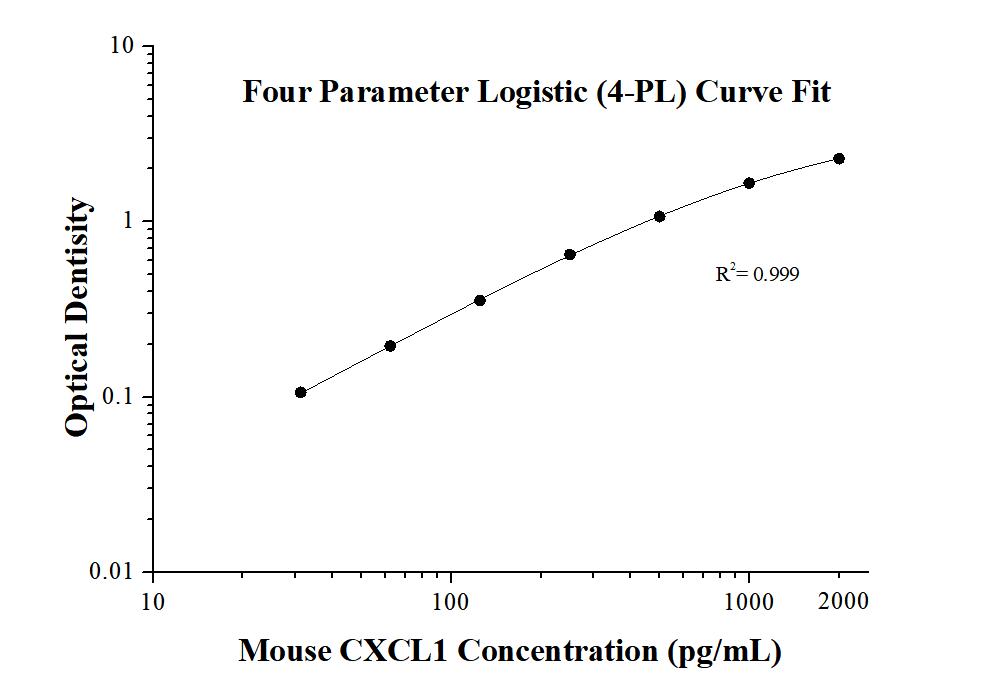Mouse CXCL1 ELISA Kit
Cat no : KE10104
Synonyms
Cxcl1, Fsp, gro, Gro1, KC, Mgsa, N51, Scyb1
Validation Data Gallery
Product Information
KE10104 is a solid phase sandwich Enzyme Linked-Immuno-Sorbent Assay (Sandwich ELISA). The mouse CXCL1 ELISA kit is to be used to detect and quantify protein levels of endogenous mouse CXCL1. The assay recognizes mouse CXCL1. An antibody specific for mouse CXCL1 has been pre-coated onto the microwells. The mouse CXCL1 protein in samples is captured by the coated antibody after incubation. Following extensive washing, another horseradish peroxidase (HRP)-conjugated antibody specific for mouse CXCL1 is added to detect the captured mouse CXCL1 protein. For signal development, followed by Tetramethyl-benzidine (TMB) reagent. Solution containing sulfuric acid is used to stop color development and the color intensity which is proportional to the quantity of bound protein is measurable at 450 nm with the correction wavelength set at 630 nm.
| Product name | Mouse CXCL1 ELISA Kit |
| Tests | 1 X 96 well plate |
| Sample type | Serum, Plasma, Cell culture supernatants |
| Assay type | Sandwich |
| Sensitivity | 1.2 pg/mL |
| Range | 31.25-2000 pg/mL |
| Reactivity | Mouse |
| Tested applications | Sandwich ELISA |
| Gene ID (NCBI) | 14825 |
Recovery
| Sample Type | Average | Range |
|---|---|---|
| Mouse serum | 94% | 80%-119% |
| Cell culture supernatants | 102% | 87%-120% |
IntraAssay
| Sample | n | mean ( pg/mL) | SD | CV% |
|---|---|---|---|---|
| 1 | 20 | 1,045.9 | 25.3 | 2.4 |
| 2 | 20 | 257.8 | 7.7 | 3.0 |
| 3 | 20 | 62.9 | 1.1 | 1.8 |
InterAssay
| Sample | n | mean ( pg/mL) | SD | CV% |
|---|---|---|---|---|
| 1 | 24 | 1,059.9 | 37.0 | 3.5 |
| 2 | 24 | 262.8 | 8.7 | 3.3 |
| 3 | 24 | 63.6 | 3.1 | 4.9 |
Background Information
CXC motif chemokine ligand 1 (CXCL1), a CXC chemokine, is also known as growth-regulated (or-related) oncogene-α (Gro-α) and melanoma growth-stimulatory activity (MGSA).It is one of seven chemokines that activate the CXC motif chemokine receptor 2 (CXCR2) and one of the most studied CXC chemokines. CXCL1 is a chemoattractant cytokine. Its most important property is to cause chemotaxis of immune cells, mainly neutrophils, and to a lesser extent CD14+ monocytes and basophils, but not T cells. It also reduces neutrophil apoptosis and thus increases the accumulation of these cells at sites of inflammatory reactions. CXCL1 also causes the chemotaxis of endothelial cells and thus participates in angiogenesis.
Properties
| Storage Instructions | All the reagents are stored at 2-8℃ for 6 months or -20℃ for 12 months. Refer to the protocol for further storage instructions. |
| Synonyms | Cxcl1, Fsp, gro, Gro1, KC, Mgsa, N51, Scyb1 |
Publications
| Species | Sample Type | Title |
|---|---|---|
Int Immunopharmacol Pharmacological inhibition of P300 with C646 ameliorates LPS-induced acute lung injury by modulating CXCL1 in M1 alveolar macrophages | ||
NanoImpact Evaluation of inflammatory and mesothelioma-related responses in mice following the intraperitoneal administration of cellulose nanofibers | ||
Nat Commun The lipid-metabolism enzyme ECI2 reduces neutrophil extracellular traps formation for colorectal cancer suppression |

